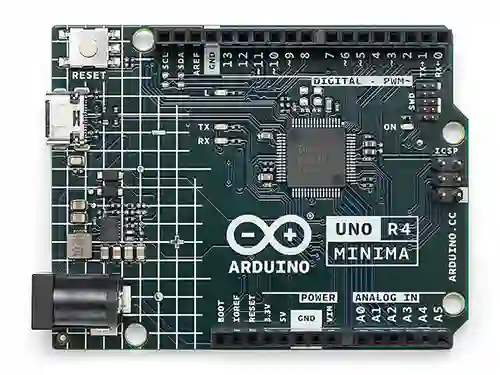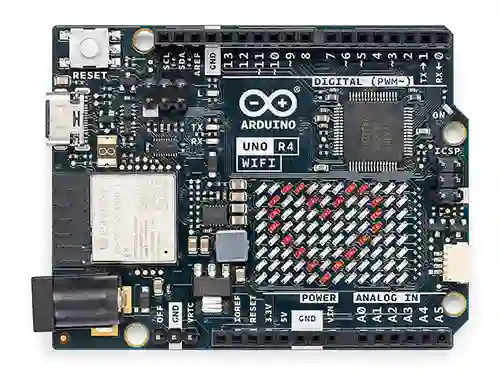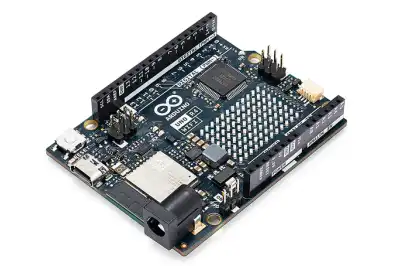Today Arduino has presented the new Arduino UNO R4 boards, which represent the evolution of the Arduino UNO family, its most popular and well-known model.
Three months ago, we reported on Arduino’s announcement of working on an improved version in terms of performance and connectivity of the Arduino UNO family. Finally, today the availability and technical characteristics of the new model have been announced.
This news has come with surprises. First of all, the Arduino R4 will be available in two versions, called Arduino UNO R4 Minima and Arduino UNO R4 WiFi. Next, we will see the main features of each model.
Arduino UNO R4 Minima
The first variant of the new Arduino UNO R4 boards is the “Minima” model. In my opinion, with a rather unfortunate name, the Minima is the natural successor of the Arduino UNO family.
The Arduino UNO R4 Minima focuses on providing improved performance, without adding new wireless communication functions. For this, it has a powerful 32-bit microcontroller @48Mhz courtesy of Renesas RA4M1 (Arm® Cortex®-M4).
In addition, the new Arduino UNO R4 has a much larger memory than previous models. We now find 256kB Flash and 32 kB RAM, compared to the 32kB Flash and 2kB RAM of the previous R3 model. As we can see, an improvement of x8 and x16.

As for connections and pinout, the new UNO R4 has a wide variety of peripherals, including 14x GPO, 6x ADC, 1x DAC, and 6x PWM. Similar, and even somewhat inferior, to the previous model. Although the DAC is appreciated.
In terms of connectivity, the board has 4x UART, 1x I2C, 1x SPI, and a CAN bus. In addition, the board has an HID interface, so it can act as a USB keyboard or mouse (something that you love, I know).
Very important, the new Arduino UNO R4 Minima maintains the popular format and compatibility in pinout and voltages with the rest of the UNO models. This allows to ensure a smooth transition for projects, shields, and existing hardware.
In addition, the Arduino UNO R4 Minima expands the input voltage range to 24V, in order to facilitate integration into projects with motors, LED strips, and other actuators, using a single power source.
The programming, as it could not be otherwise, is done with the Arduino IDE. For this purpose, a USB-C connector is included (finally!). In addition, as a novelty, an SWD connector for debug and monitoring is incorporated.
Arduino UNO R4 WiFI
As for the Arduino UNO R4 WiFi, we find a board with the same technical characteristics as the R4 Minima, adding wireless connectivity and an LED matrix.
For WiFi and Bluetooth connectivity, the Arduino UNO R4 WiFi board relies on an Espressif ESP32-S3 module. Therefore, it has two processors, the main Renesas RA4M1 and the secondary for WiFi.
A “curious” decision to say the least, considering that the ESP32-S3, with its @240Mhz, 384 kB ROM, and 512 kB SRAM, is a much more powerful processor than the RA4M1. Well, there it is.

The other “secret” hidden in the first images of the Arduino UNO R4 WiFi, which were covered by a rectangle, is a 12x8 red LED matrix. This matrix clearly reminds us of others available on boards such as the microbit, a highly appreciated model for STEAM introduction and teaching.
Personally, I would have been much happier with a TFT screen, like the ones we find in M5Stack or Lilygo products. Even if it was a monochrome OLED screen, it would have been very useful. Well, we will wait for the UNO R5 version.
Another difference from the Minima is that the UNO R4 WiFi incorporates a Qwiic connector. This connector, found in Sparkfun devices, “competes” with the Grove connector as a way to facilitate the connection of devices between I2C.
Finally, it includes support for battery-powered RTC. For this purpose, it has additional pins, including an “OFF” pin to turn off the board and a “VRTC” pin to keep the internal Real Time Clock powered and operational.
Characteristics
Let’s see the characteristics of the Arduino UNO R4 Minima and WiFi, compared side by side.
| Category | Characteristic | Arduino® UNO R4 Minima | Arduino® UNO R4 WiFi |
|---|---|---|---|
| SKU | ABX00087 | ABX00087 | |
| MCU | Renesas RA4M1 (Arm® Cortex®-M4) | 48 MHz | 48 MHz |
| ESP32-S3 | ❌ | 240 MHz | |
| Clock | Main core | 48 MHz | 48 MHz |
| Memory | RA4M1 | 256 kB Flash, 32 kB RAM | 256 kB Flash, 32 kB RAM |
| ESP32-S3 | ❌ | 384 kB ROM, 512 kB SRAM | |
| Pins | Digital I/O Pins | 14 | 14 |
| Analog input pins | 6 | 6 | |
| DAC | 1 | 1 | |
| PWM pins | 6 | 6 | |
| Connectivity | UART | 4 | 4 |
| I2C | 1 | 1 | |
| SPI | 1 | 1 | |
| CAN Bus | 1 | 1 | |
| Display | 12x8 red LED matrix | ❌ | ✔️ |
| Communication | Wi-Fi | ❌ | ✔️ |
| Bluetooth | ❌ | ✔️ | |
| Power | Circuit operating voltage | 5 V | 5 V (ESP32-S3 3.3 V) |
| Input voltage (VIN) | 6-24 V | 6-24 V | |
| DC Current per I/O Pin | 8 mA | 8 mA | |
| Connectors | USB-C® | ✔️ | ✔️ |
| SWD | ✔️ | ✔️ | |
| Qwiik | ❌ | ✔️ | |
| Dimensions | Length | 68.85 mm | 68.85 mm |
| Width | 53.34 mm | 53.34 mm |
Conclusion
Obviously, the Arduino UNO is the best-known model of our beloved Arduino brand. Therefore, it is very important to make the effort to maintain hardware compatibility and, as far as possible, existing software and libraries.
The UNO R4 Minima is a good facelift both in power and memory. While the UNO R4 WiFi model improves the device with more features, as well as incorporating WiFi and Bluetooth connectivity.
Personally, today I don’t understand a project that doesn’t have some type of wireless connectivity. I’m simply not interested. So, you can imagine that my recommendation leans towards the WiFi model.
As for the price, the UNO R4 Minima model goes on sale for 18€, while the UNO R4 WiFi goes up to 25€. A price that remains in line with previous models, while offering much superior features. So, good news!
On the other hand, the environment in which the UNO R4 is launched is very different from years ago, and there are many more alternatives. It is inevitable to make comparisons with other devices in the market, such as the Raspberry Pico or our powerful and beloved ESP32.
The Pico can be found for less than half the price, and is much more powerful. And the ESP32 can be found for 4-5€, and it is simply impossible to compete with it. Hence, it is even more curious to have included one as a WiFi module (if you can’t beat the enemy…?)
However, as always, it is worth noting that one of Arduino’s strengths is its community, support, documentation, and the focus on introducing electronics. These aspects, and not just the price, are important considerations when choosing Arduino as an option.
In short, the Arduino UNO R4 boards are a well-deserved and long-awaited update for the UNO family that offers improved power and optional wireless connectivity options. Mainly aimed at beginners, electronics enthusiasts, and the STEAM education sector, they are sure to be a highly appreciated option in the maker community.
